Advancements and Applications of Wood-Based Sandwich Panels in Modern Construction
Abstract
:1. Introduction
2. Definition, Composition, and Structure
3. Manufacturing Technologies
3.1. Fabrication
3.2. Innovations in Material Technology
4. Properties of Wood-Based Sandwich Panels for Buildings
4.1. Mechanical Properties and Their Applications in Construction
4.2. Thermal Insulation Capabilities Linked to Sustainable Construction
4.3. Sound Insulation and Absorption in Building Design
4.4. Fire Resistance in Wood-Based Sandwich Panels
5. Applications of Wood-Based Sandwich Panels in Construction
5.1. Conventional and Modern Uses in Construction
5.2. Sustainability and Environmental Impacts
5.3. Challenges and Opportunities
6. Concluding Remarks
- Structural performance. These panels’ high strength-to-weight ratio enhances structural performance while minimizing the load on foundations and supporting structures, making them versatile for various construction applications.
- Energy efficiency. The panels’ superior thermal insulation significantly reduces energy consumption for building heating and cooling, contributing to greater energy efficiency.
- Sustainability. Using renewable materials in these panels supports sustainable construction practices, contributing to lower carbon footprints in building projects. Technological advances, such as automation and additive manufacturing, have improved production efficiency, resulting in cost savings and reduced material waste.
- Economic considerations. While advanced manufacturing technologies involve high initial costs, their long-term benefits include reduced labour costs, higher production efficiency, and lower material waste. Comprehensive economic analyses can assist decision-makers in adopting these technologies.
- Enhanced thermal insulation. Exploring ways to further enhance the thermal insulation properties of wood-based sandwich panels will help maximize building energy savings.
- Fire resistance. Current fire resistance measures, while promising, require further development to enhance the panels’ inherent fire-resistant properties. Developing and testing new fire-resistant materials and coatings will enhance safety.
- Durability. Long-term durability concerns remain, particularly related to exposure to moisture, temperature fluctuations, and UV radiation. Future research should investigate new materials and treatments to improve the long-term performance of wood-based sandwich panels under various environmental conditions.
- Standardization and performance data. Standardized testing and evaluation methods are needed to ensure consistent performance and safety. Additionally, extensive data on these panels’ long-term performance and ageing under varying environmental conditions is necessary.
- Economic viability. Detailed cost–benefit analyses of different manufacturing technologies are needed to determine the most cost-effective methods for large-scale production.
Funding
Conflicts of Interest
References
- Allen, H.G. Analysis and Design of Structural Sandwich Panels, 1st ed.; The Commonwealth and International Library; Structures and Solid Body Mechanics Division; Elsevier: Southampton, UK, 1969; ISBN 978-1-4831-5904-1. [Google Scholar]
- Gibson, L.J.; Ashby, M.F. The mechanics of three-dimensional cellular materials. Proc. R. Soc. Lond. A 1982, 382, 43–59. [Google Scholar] [CrossRef]
- Zenkert, D. An Introduction to Sandwich Structures, 2nd ed.; Dan Zenkert: Stockholm, Sweden, 1995. [Google Scholar]
- Wei, P.; Chen, J.; Zhang, Y.; Pu, L. Wood-based sandwich panels: A review. Wood Res. 2021, 66, 875–890. [Google Scholar] [CrossRef]
- Bais-Moleman, A.L.; Sikkema, R.; Vis, M.; Reumerman, P.; Theurl, M.C.; Erb, K.-H. Assessing wood use efficiency and greenhouse gas emissions of wood product cascading in the European Union. J. Clean. Prod. 2018, 172, 3942–3954. [Google Scholar] [CrossRef]
- Upton, B.; Miner, R.; Spinney, M.; Heath, L.S. The greenhouse gas and energy impacts of using wood instead of alternatives in residential construction in the United States. Biomass Bioenergy 2008, 32, 1–10. [Google Scholar] [CrossRef]
- Myllyviita, T.; Soimakallio, S.; Judl, J.; Seppälä, J. Wood substitution potential in greenhouse gas emission reduction—Review on current state and application of displacement factors. For. Ecosyst. 2021, 8, 42. [Google Scholar] [CrossRef]
- Barbu, M.; Jan, L.; Thömen, H.; Welling, J. New technology for the continuous production of wood-based lightweight panels. In Proceedings of the International Convention of Society of Wood Science and Technology and United Nations Economic Commission for Europe—Timber Committee, Geneva, Switzerland, 11–14 October 2010; pp. 1–10. [Google Scholar]
- Grenestedt, J.L.; Bekisli, B. Analyses and preliminary tests of a balsa sandwich core with improved shear properties. Int. J. Mech. Sci. 2003, 45, 1327–1346. [Google Scholar] [CrossRef]
- Mazzuca, P. Flexural behaviour of GFRP sandwich panels with eco-friendly PET foam core for the rehabilitation of building floors. Structures 2024, 60, 105815. [Google Scholar] [CrossRef]
- Labans, E.; Kalnins, K.; Bisagni, C. Flexural behavior of sandwich panels with cellular wood, plywood stiffener/foam and thermoplastic composite core. J. Sandw. Struct. Mater. 2017, 21, 109963621769958. [Google Scholar] [CrossRef]
- Correia, J.R.; Garrido, M.; Gonilha, J.A.; Branco, F.A.; Reis, L.G. GFRP sandwich panels with PU foam and PP honeycomb cores for civil engineering structural applications: Effects of introducing strengthening ribs. Int. J. Struct. Integr. 2012, 3, 127–147. [Google Scholar] [CrossRef]
- Kawasaki, T.; Kawai, S. Thermal insulation properties of wood-based sandwich panel for use as structural insulated walls and floors. J. Wood Sci. 2006, 52, 75–83. [Google Scholar] [CrossRef]
- Mostafa, A.; Shankar, K.; Morozov, E.V. Behaviour of PU-foam/glass-fibre composite sandwich panels under flexural static load. Mater. Struct. 2015, 48, 1545–1559. [Google Scholar] [CrossRef]
- Fam, A.; Sharaf, T. Flexural performance of sandwich panels comprising polyurethane core and GFRP skins and ribs of various configurations. Compos. Struct. 2010, 92, 2927–2935. [Google Scholar] [CrossRef]
- Zhang, F.; Liu, W.; Fang, H.; Jia, Z. Flexural behavior of composite sandwich beams with different kinds of GFRP ribs in flatwise and edgewise positions. Compos. Part B Eng. 2019, 156, 229–239. [Google Scholar] [CrossRef]
- Xie, J.; Chen, F.; Zhao, J.; Lu, P.; Liu, F.; Li, L. Flexural behaviour of full-scale precast recycled concrete sandwich panels with BFRP connectors. J. Build. Eng. 2022, 56, 104816. [Google Scholar] [CrossRef]
- Zhou, A.; Keller, T. Joining techniques for fiber reinforced polymer composite bridge deck systems. Compos. Struct. 2005, 69, 336–345. [Google Scholar] [CrossRef]
- Abdolpour, H. Development of Prefabricated Modular Houses in Pure Composite Sandwich Panels. Ph.D. Thesis, Universidade do Minho Escola de Engenharia, Braga/Guimarães, Portugal, 2017. [Google Scholar]
- Klímek, P.; Wimmer, R.; Brabec, M.; Sebera, V. Novel sandwich panel with interlocking plywood kagome lattice core and grooved particleboard facings. Bioresources 2016, 11, 195–208. [Google Scholar] [CrossRef]
- Gao, Y.; Xuan, S.; Xu, F.; Diao, Y.; Meng, X. Shear performance of a novel non-metallic cross-laminated timber wall-to-wall connection using double-dovetail mortise-tenon joint. Wood Mater. Sci. Eng. 2023, 18, 1003–1013. [Google Scholar] [CrossRef]
- Qi, G.; Chen, Y.-L.; Richert, P.; Ma, L.; Schröder, K.U. A hybrid joining insert for sandwich panels with pyramidal lattice truss cores. Compos. Struct. 2020, 241, 112123. [Google Scholar] [CrossRef]
- Garrido, M.; Correia, J.R.; Keller, T.; Branco, F.A. Connection systems between composite sandwich floor panels and load-bearing walls for building rehabilitation. Eng. Struct. 2016, 106, 209–221. [Google Scholar] [CrossRef]
- Burnard, M.D.; Kutnar, A. Wood and human stress in the built indoor environment: A review. Wood Sci. Technol. 2015, 49, 969–986. [Google Scholar] [CrossRef]
- Burnard, M.D.; Kutnar, A. Human stress responses in office-like environments with wood furniture. Build. Res. Inf. 2020, 48, 316–330. [Google Scholar] [CrossRef]
- Kotradyova, V.; Vavrinsky, E.; Kalinakova, B.; Petro, D.; Jansakova, K.; Boles, M.; Svobodova, H. Wood and its impact on humans and environment quality in health care facilities. Int. J. Environ. Res. Public Health 2019, 16, 3496. [Google Scholar] [CrossRef] [PubMed]
- Alapieti, T.; Mikkola, R.; Pasanen, P.; Salonen, H. The influence of wooden interior materials on indoor environment: A review. Eur. J. Wood Prod. 2020, 78, 617–634. [Google Scholar] [CrossRef]
- McNair, S. Wood in the Built Environment: The Restorative Benefits of Wood on Student Health and Well-Being; Final Report for DESN 47900 Design Research 2; Faculty of Animation, Arts & Design, Sheridan College: Ottawa, ON, Canada, 2021. [Google Scholar]
- Costa, D.; Serra, J.; Quinteiro, P.; Dias, A.C. Life cycle assessment of wood-based panels: A review. J. Clean. Prod. 2024, 444, 140955. [Google Scholar] [CrossRef]
- Santos, P.; Correia, J.R.; Godinho, L.; Dias, A.M.P.G.; Dias, A. Life cycle analysis of cross-insulated timber panels. Structures 2021, 31, 1311–1324. [Google Scholar] [CrossRef]
- Akkan, A.; Vural, N. Thermal, sound and fire performance properties of prefabricated façade panels with massive, sandwich and frame design concepts. J. Archit. Sci. Appl. 2022, 7, 464–481. [Google Scholar] [CrossRef]
- Estrada-Martínez, S.; Mollón, V.; Bonhomme, J. Proposals to improve the durability assessment after ageing tests for wood-based sandwich panels. JNL Sandw. Struct. Mater. 2017, 19, 216–230. [Google Scholar] [CrossRef]
- Martins, R.H.B.; Barbirato, G.H.A.; Campos Filho, L.E.; Fiorelli, J.; Martins, R.H.B.; Barbirato, G.H.A.; Campos Filho, L.E.; Fiorelli, J. OSB sandwich panel with undulated core of balsa wood waste. Maderas. Cienc. Y Tecnol. 2023, 25. [Google Scholar] [CrossRef]
- Chen, Z.; Yan, N. Investigation of elastic moduli of kraft paper honeycomb core sandwich panels. Compos. Part B Eng. 2012, 43, 2107–2114. [Google Scholar] [CrossRef]
- Shalbafan, A.; Luedtke, J.; Welling, J.; Thoemen, H. Comparison of foam core materials in innovative lightweight wood-based panels. Eur. J. Wood Prod. 2012, 70, 287–292. [Google Scholar] [CrossRef]
- Pflug, J.; Vangrimde, B.; Verpoest, I. Material efficiency and cost effectiveness of sandwich materials. Int. Sampe Symp. Exhib. 2003, 14, 1925–1937. [Google Scholar]
- Ugale, V.; Singh, K.; Mishra, N.; Kumar, P. Experimental studies on thin sandwich panels under impact and static loading. J. Reinf. Plast. Compos. 2013, 32, 420–434. [Google Scholar] [CrossRef]
- Labans, E.; Kalnins, K. Experimental validation of the stiffness optimisation for plywood sandwich panels with rib-stiffened core. Wood Res. 2014, 59, 793–802. [Google Scholar]
- COMPOCEL® WF-PVC Foam Core Sandwich Panel by Cel Components S.r.l.|DirectIndustry. Available online: https://www.directindustry.com/prod/cel-components-srl/product-38588-708283.html (accessed on 5 April 2024).
- Honeycomb Panels Australia—Online Store. Available online: https://salepeaket.live/product_tag/37026621_.html (accessed on 5 April 2024).
- Superlight Panel—Sandwich Panel, Okoumè, Blond Compact Cork. Available online: https://www.ramec.it/en/prodotti/superlight-panel-pannello-sandwich-okoume-sughero-compatto-biondo/ (accessed on 5 April 2024).
- Edgars, L.; Kaspars, Z.; Kaspars, K. Structural performance of wood based sandwich panels in four point bending. Procedia Eng. 2017, 172, 628–633. [Google Scholar] [CrossRef]
- Zhang, F.; Xu, J.; Esther, B.; Lu, H.; Fang, H.; Liu, W. Effect of shear span-to-depth ratio on the mechanical behavior of composite sandwich beams with GFRP ribs and balsa wood core materials. Thin-Walled Struct. 2020, 154, 106799. [Google Scholar] [CrossRef]
- Manalo, A.; Aravinthan, T.; Fam, A.; Benmokrane, B. State-of-the-art review on FRP sandwich systems for lightweight civil infrastructure. J. Compos. Constr. 2016, 21, 16. [Google Scholar] [CrossRef]
- Merli, F.; Belloni, E.; Buratti, C. Eco-sustainable wood waste panels for building applications: Influence of different species and assembling techniques on thermal, acoustic, and environmental performance. Buildings 2021, 11, 361. [Google Scholar] [CrossRef]
- Köhler, R.; Jurisch, M.; Mayer, A.K.; Mai, C.; Viöl, W. Loofah sandwich panels: The effect of adhesive content on mechanical and physical properties. Materials 2022, 15, 7129. [Google Scholar] [CrossRef] [PubMed]
- Jantawee, S.; Lim, H.; Li, M.; Oh, J.-K.; Pasztory, Z.; Cho, H.; Srivaro, S. Developing structural sandwich panels for energy-efficient wall applications using laminated oil palm wood and rubberwood-based plywood/oriented strand board. J. Wood Sci. 2023, 69, 35. [Google Scholar] [CrossRef]
- Mohammadabadi, M.; Miller, J.; Street, J.; Kim, Y.; Ragon, K. Wood-based corrugated core sandwich panels manufactured using a wooden mold. BioResources 2023, 18, 3033. [Google Scholar] [CrossRef]
- Semple, K.E.; Sam-Brew, S.; Deng, J.; Cote, F.; Yan, N.; Chen, Z.; Smith, G.D. Properties of commercial kraft paper honeycomb furniture stock panels conditioned under 65 and 95 percent relative humidity. For. Prod. J. 2015, 65, 106–122. [Google Scholar] [CrossRef]
- Burnett, M.P.; Kharazipour, A. Mechanical behaviour of a lightweight, three-layered sandwich panel based on the raw material maize. Holzforschung 2018, 72, 65–70. [Google Scholar] [CrossRef]
- Mustapha, K. Manufacturing, applications and mechanical properties of lightweight wood-based sandwich panels. In Reference Module in Materials Science and Materials Engineering; Elsevier: Amsterdam, The Netherlands, 2018; ISBN 978-0-12-803581-8. [Google Scholar]
- Phohchuay, P.; Khongtong, S. Insulated sandwich panels from natural rubber and rubber wood. Srinakharinwirot Sci. J. 2008, 34, 31–44. [Google Scholar]
- Fajrin, J. Sustainable Hybrid Composite Sandwich Panel with Natural Fibre Composites as Intermediate Layer. Ph.D. Thesis, University of Southern Queensland, Toowoomba, QLD, Australia, 2013. [Google Scholar]
- Vitale, J.P.; Francucci, G.; Stocchi, A. Thermal conductivity of sandwich panels made with synthetic and vegetable fiber vacuum-infused honeycomb cores. JNL Sandw. Struct. Mater. 2017, 19, 66–82. [Google Scholar] [CrossRef]
- Zhu, D.; Shi, H.; Fang, H.; Liu, W.; Qi, Y.; Bai, Y. Fiber reinforced composites sandwich panels with web reinforced wood core for building floor applications. Compos. Part B Eng. 2018, 150, 196–211. [Google Scholar] [CrossRef]
- Antov, P.; Savov, V.; Neykov, N. Sustainable bio-based adhesives for eco-friendly wood composites. A review. Wood Res. 2020, 65, 51–62. [Google Scholar] [CrossRef]
- Oliveira, P.R.; May, M.; Panzera, T.H.; Hiermaier, S. Bio-based/green sandwich structures: A review. Thin-Walled Struct. 2022, 177, 109426. [Google Scholar] [CrossRef]
- Soubam, T.; Gupta, A. Eco-friendly natural rubber latex and modified starch-based adhesive for wood-based panels application—A review. Maejo Int. J. Energy Environ. Commun. 2021, 3, 49–53. [Google Scholar] [CrossRef]
- Orlowski, K. Automated manufacturing for timber-based panelised wall systems. Autom. Constr. 2020, 109, 102988. [Google Scholar] [CrossRef]
- Smardzewski, J.; Maslej, M.; Wojciechowski, K.W. Compression and low velocity impact response of wood-based sandwich panels with auxetic lattice core. Eur. J. Wood Prod. 2021, 79, 797–810. [Google Scholar] [CrossRef]
- Zarna, C.; Chinga-Carrasco, G.; Echtermeyer, A.T. Biocomposite panels with unidirectional core stiffeners—3-point bending properties and considerations on 3D printing and extrusion as a manufacturing method. Compos. Struct. 2023, 313, 116930. [Google Scholar] [CrossRef]
- Cao, D.; Bouzolin, D.; Lu, H.; Griffith, D.T. Bending and shear improvements in 3D-printed core sandwich composites through modification of resin uptake in the skin/core interphase region. Compos. Part B Eng. 2023, 264, 110912. [Google Scholar] [CrossRef]
- Garrido, M.; Madeira, J.F.A.; Proença, M.; Correia, J.R. Multi-objective optimization of pultruded composite sandwich panels for building floor rehabilitation. Constr. Build. Mater. 2019, 198, 465–478. [Google Scholar] [CrossRef]
- Jiang, L.; Walczyk, D.; McIntyre, G.; Bucinell, R.; Li, B. Bioresin infused then cured mycelium-based sandwich-structure biocomposites: Resin transfer molding (RTM) process, flexural properties, and simulation. J. Clean. Prod. 2019, 207, 123–135. [Google Scholar] [CrossRef]
- Kim, T.; Lee, U.-K.; Yoo, W.S.; An, S.-H.; Cho, H.; Lee, Y.; Doh, N. Benefit/cost analysis of a robot-based construction automation system. In Proceedings of the IEEE International Conference on Control, Automation and Systems (ICCAS 2010), Goyang-si, Republic of Korea, 27 October 2010; pp. 616–621. [Google Scholar]
- Feng, Y.; Qiu, H.; Gao, Y.; Zheng, H.; Tan, J. Creative design for sandwich structures: A review. Int. J. Adv. Robot. Syst. 2020, 17, 1729881420921327. [Google Scholar] [CrossRef]
- Kladovasilakis, N.; Charalampous, P.; Tsongas, K.; Kostavelis, I.; Tzetzis, D.; Tzovaras, D. Experimental and computational investigation of lattice sandwich structures constructed by additive manufacturing technologies. J. Manuf. Mater. Process. 2021, 5, 95. [Google Scholar] [CrossRef]
- Monteiro, S.; Martins, J.; Magalhães, F.D.; Carvalho, L. Lightweight wood composites: Challenges, production and performance. In Lignocellulosic Composite Materials; Kalia, S., Ed.; Springer International Publishing: Cham, Switzerland, 2018; pp. 293–322. ISBN 978-3-319-68696-7. [Google Scholar]
- Almutairi, A.D.; Bai, Y.; Ferdous, W. Flexural behaviour of GFRP-softwood sandwich panels for prefabricated building construction. Polymers 2023, 15, 2102. [Google Scholar] [CrossRef]
- Hussain, M.; Abbas, N.; Zahra, N.; Sajjad, U.; Awan, M.B. Investigating the performance of GFRP/wood-based honeycomb sandwich panels for sustainable prefab building construction. SN Appl. Sci. 2019, 1, 875. [Google Scholar] [CrossRef]
- Osei-Antwi, M.; De Castro, J.; Vassilopoulos, A.P.; Keller, T. Fracture in complex balsa cores of fiber-reinforced polymer sandwich structures. Constr. Build. Mater. 2014, 71, 194–201. [Google Scholar] [CrossRef]
- Dawood, M.; Ballew, W.; Seiter, J. Enhancing the resistance of composite sandwich panels to localized forces for civil infrastructure and transportation applications. Compos. Struct. 2011, 93, 2983–2991. [Google Scholar] [CrossRef]
- Lakreb, N.; Bezzazi, B.; Pereira, H. Mechanical behavior of multilayered sandwich panels of wood veneer and a core of cork agglomerates. Mater. Des. (1980–2015) 2015, 65, 627–636. [Google Scholar] [CrossRef]
- Pradhan, S.; Mohammadabadi, M.; Entsminger, E.D.; Ragon, K.W.; Khademibami, L.; Street, J.T. Development of a high-performance building material using wood-based corrugated panels manufactured via cold-forming technique. BioResources 2023, 18, 4666–4675. [Google Scholar] [CrossRef]
- Matalkah, F.; Bharadwaj, H.; Soroushian, P.; Wu, W.; Almalkawi, A.; Balachandra, A.M.; Peyvandi, A. Development of sandwich composites for building construction with locally available materials. Constr. Build. Mater. 2017, 147, 380–387. [Google Scholar] [CrossRef]
- Wang, L.; Liu, W.; Hui, D. Compression strength of hollow sandwich columns with GFRP skins and a paulownia wood core. Compos. Part B Eng. 2014, 60, 495–506. [Google Scholar] [CrossRef]
- Li, J.; Hunt, J.F.; Gong, S.; Cai, Z. High strength wood-based sandwich panels reinforced with fiberglass and foam. BioResources 2014, 9, 1898–1913. [Google Scholar] [CrossRef]
- Kljak, J.; Brezovi, M. Influence of plywood structure on sandwich panel properties: Variability of veneer thickness ratio. Wood Res. 2007, 52, 77–78. [Google Scholar]
- Smardzewski, J. Experimental and numerical analysis of wooden sandwich panels with an auxetic core and oval cells. Mater. Des. 2019, 183, 108159. [Google Scholar] [CrossRef]
- Yang, F.; Fei, B. The research on bamboo-wood corrugated sandwich panel. In Proceedings of the 55th International Convention of Society of Wood Science and Technology, Beijing, China, 27 August 2012. [Google Scholar]
- Smardzewski, J.; Krzyżaniak, Ł.; Wojciechowski, K.W.; Peliński, K.; Tretiakov, K.V.; Narojczyk, J.W. Bending performance and failure behavior of wooden sandwich panels with corrugated cores. Phys. Status Solidi B 2022, 259, 2200423. [Google Scholar] [CrossRef]
- Luengo, E.; Arriaga, F.; Bobadilla, I.; Hermoso, E. Mechanical efficiency and quality control preliminary analysis of incompletely bonded wood-based sandwich panels. Forests 2023, 14, 1074. [Google Scholar] [CrossRef]
- Gozdecki, C.; Kociszewski, M. The properties of sandwich panels made of standard wood-based panels. Annals of Warsaw University of Life Sciences—SGGW. For. Wood Technol. 2021, 114. [Google Scholar] [CrossRef]
- Forest Products Laboratory (FPL). Wood Handbook-Wood as an Engineering Material; General Technical Report FPL-GTR-190; U.S. Department of Agriculture, Forest Service, Forest Products Laboratory: Madison, WI, USA, 2010.
- PROFHOLOD. Energy Safe Technologies. PIR Premier and PUR Classic Sandwich Panels. Available online: https://profholod.com/uploads/pdf/PIR_PREMIER_2021.pdf (accessed on 24 May 2024).
- Aslan, M.; Öztürk, H.; DemïRkir, C. Investigation of thermal conductivity of wood sandwich panels with aluminium and polypropylene core. J. Anatol. Environ. Anim. Sci. 2019, 4, 647–650. [Google Scholar] [CrossRef]
- Alavez-Ramirez, R.; Chiñas-Castillo, F.; Morales-Dominguez, V.J.; Ortiz-Guzman, M. Thermal conductivity of coconut fibre filled ferrocement sandwich panels. Constr. Build. Mater. 2012, 37, 425–431. [Google Scholar] [CrossRef]
- Srivaro, S.; Pásztory, Z.; Le Duong, H.A.; Lim, H.; Jantawee, S.; Tomad, J. Physical, mechanical and thermal properties of cross laminated timber made with coconut wood. Eur. J. Wood Prod. 2021, 79, 1519–1529. [Google Scholar] [CrossRef]
- LVL by Stora Enso Technical Brochure. Stora Enso Wood Products GmbH. Helsinki. Finland. Available online: https://www.storaenso.com/-/media/documents/download-center/documents/product-brochures/wood-products/lvl-by-stora-enso-technical-brochure-en.pdf (accessed on 4 June 2021).
- Thermal Conductivity, Specific Heat Capacity and Density. Available online: https://help.iesve.com/ve2021/table_6_thermal_conductivity__specific_heat_capacity_and_density.htm (accessed on 9 May 2024).
- Goss, W.P.; Miller, R.G. Thermal properties of wood and wood products. In Proceedings of the Thermal Performance of the Exterior Envelopes of Whole Buildings International Conference, Clearwater Beach, FL, USA, 7–10 December 1992; Volume 28, pp. 193–203. [Google Scholar]
- Stora Enso CLT by Stora Enso Building Physics. Available online: https://www.storaenso.com/-/media/documents/download-center/documents/product-specifications/wood-products/clt-technical/clt-by-stora-enso-technical-documentation---building-physics--2021-9-en.pdf (accessed on 8 May 2024).
- Technical Specification of CLT Panels. Available online: https://cltprofi.com/clt-panels-technical-information/ (accessed on 9 May 2024).
- Oriented Strand Board-European Panel Federation. Available online: https://europanels.org/the-wood-based-panel-industry/types-of-wood-based-panels-economic-impact/oriented-strand-board/ (accessed on 9 May 2024).
- Tripathi, J.; Rice, R.W. Thermal conductivity values for laminated strand lumber and spruce for use in hybrid cross-laminated timber panels. BioResources 2017, 12, 8827–8837. [Google Scholar] [CrossRef]
- Daza-Badilla, L.; Gómez, R.; Díaz-Noriega, R.; Avudaiappan, S.; Skrzypkowski, K.; Saavedra-Flores, E.I.; Korzeniowski, W. Thermal conductivity in concrete samples with natural and synthetic fibers. Materials 2024, 17, 817. [Google Scholar] [CrossRef]
- Solids, Liquids and Gases-Thermal Conductivities Thermal Conductivity Coefficients for Insulation Materials, Aluminum, Asphalt, Brass, Copper, Steel, Gases and More. Available online: https://www.engineeringtoolbox.com/thermal-conductivity-d_429.html (accessed on 9 May 2024).
- Zhang, A.; Li, Y. Thermal conductivity of aluminum alloys—A review. Materials 2023, 16, 2972. [Google Scholar] [CrossRef]
- Lakreb, N.; Knapic, S.; Machado, J.S.; Bezzazi, B.; Pereira, H. Properties of multilayered sandwich panels with an agglomerated cork core for interior applications in buildings. Eur. J. Wood Prod. 2018, 76, 143–153. [Google Scholar] [CrossRef]
- Garay, R.M.; Pino, G.N. Acoustic behavior in three types of housing: Brick social housing, structural insulated panel (SIP) emergency housing and mediagua emergency housing. J. Constr. 2019, 18, 96–110. [Google Scholar] [CrossRef]
- Pagnoncelli, L.; Morales, F. Cross-laminated timber system (CLT): Laboratory and in situ measurements of airborne and impact sound insulation. In Proceedings of the EuroRegio 2016, Porto, Portugal, 13–15 June 2016. [Google Scholar]
- STC Rating: Understanding Sound Transmission Class Rating|ASI. Acoustical Surfaces. Available online: https://www.acousticalsurfaces.com/blog/acoustics-education/sound-transmission-class-stc-rating/ (accessed on 10 May 2024).
- Smardzewski, J.; Kamisiński, T.; Dziurka, D.; Mirski, R.; Majewski, A.; Flach, A.; Pilch, A. Sound absorption of wood-based materials. Holzforschung 2015, 69, 431–439. [Google Scholar] [CrossRef]
- UNE-EN 13501-1 Classification of Reaction to Fire of Construction Products. Available online: https://texfire.net/en/content/une-en-13501-1-classification-of-reaction-to-fire-of-construction-products (accessed on 9 May 2024).
- Rusinová, M.; Kalousek, M.; Šlanhof, J. Assessment of the dynamic temperature profile in fire loaded sandwich structures based on wood in comparison with conventional structural systems. Appl. Mech. Mater. 2019, 887, 98–105. [Google Scholar] [CrossRef]
- EN 13501-1; Fire Test for Building Materials-Equipment. Available online: https://www.motistech.com/solution/en-13501-1 (accessed on 9 May 2024).
- ISO 834-1:1999/Amd 2:2021; Fire-Resistance Tests-Elements of Building Construction—Part 1: General Requirements-Amendment 2 2021. ISO: Geneve, Switzerland, 2021.
- ASTM E119-20; Standard Test Methods for Fire Tests of Building Construction and Materials. American Society for Testing and Materials (ASTM) International: West Conshohocken, PA, USA, 2020.
- Mosallam, A.; Abdi, F.; Qian, Z. Fire resistance simulation of loaded deck sandwich panel and deck-bulkhead assembly structures. Compos. Part B Eng. 2008, 39, 191–195. [Google Scholar] [CrossRef]
- Proença, M.; Garrido, M.; Correia, J.R.; Gomes, M.G. Fire resistance behaviour of GFRP-polyurethane composite sandwich panels for building floors. Compos. Part B Eng. 2021, 224, 109171. [Google Scholar] [CrossRef]
- IZOPANEL. Sandwich Panels Manufacturer’s Catalogue. Available online: https://www.izopanel.org/files/sandwich_panels_2017.pdf (accessed on 6 April 2024).
- EN 1634-1:2016+A1:2018; Fire Resistance and Smoke Control Tests for Door and Shutter Assemblies, Openable Windows and Elements of Building Hardware—Part 1: Fire Resistance Test for Door and Shutter Assemblies and Openable Windows. European Committee for Standardization (CEN): Brussels, Builgium, 2018.
- Wi, S.; Kim, Y.U.; Choi, J.Y.; Shin, B.; Kim, S. Active protection against fire: Enhancing the flame retardancy of sandwich panels using an expandable graphite layer formation. Int. J. Therm. Sci. 2024, 195, 108658. [Google Scholar] [CrossRef]
- Bourbigot, S.; Bachelet, P.; Samyn, F.; Jimenez, M.; Duquesne, S. Intumescence as method for providing fire resistance to structural composites: Application to poly(ethylene terephtalate) foam sandwich–structured composite. Compos. Interfaces 2013, 20, 269–277. [Google Scholar] [CrossRef]
- Beh, J.H.; Yew, M.C.; Saw, L.H. Development of lightweight fire resistant sandwich panel. IOP Conf. Ser. Earth Environ. Sci. 2020, 476, 012031. [Google Scholar] [CrossRef]
- Zenkert, D. The Handbook of Sandwich Construction; Engineering Materials Advisory Services: Columbus, OH, USA, 1997. [Google Scholar]
- What Are SIPs? Summary Definition and Benefits of Structural Insulated Panels (SIPs). Available online: https://www.sips.org/what-are-sips (accessed on 4 April 2024).
- TEK Cladding Panel|Kingspan GB. Available online: https://www.kingspan.com/gb/en/products/structural-insulated-panels/tek-cladding-panel/ (accessed on 24 April 2024).
- Mullens, M.A.; Arif, M. Structural insulated panels: Impact on the residential construction process. J. Constr. Eng. Manag. 2006, 132, 786–794. [Google Scholar] [CrossRef]
- Baechler, M.; Hadley, D.; Sparkman, R.; Homes, G. Pushing the envelope: A case study of building the first manufactured home using structural insulated panels. In Proceedings of the American Council for an Energy-Efficient Economy (ACEEE) Residential Buildings: Technologies, Design, Performance Analysis, and Building Industry Trends, Washington, DC, USA, 18–23 August 2002; pp. 1.29–1.41. [Google Scholar]
- Huber Engineered Woods LLC. An Overview of 2022. Warranties. Available online: https://www.huberwood.com/blog/warranties (accessed on 4 April 2024).
- Starcell. Honeycomb and Composite Panels, Italy. Available online: https://www.starcellspa.com/edilizia-2/?lang=en (accessed on 4 April 2024).
- New Sustainable Hybrid Sandwich Elements Combine Concrete and Wood|Informed Infrastructure. Available online: https://informedinfrastructure.com/68583/new-sustainable-hybrid-sandwich-elements-combine-concrete-and-wood/ (accessed on 5 April 2024).
- Liu, C.-X.; Fu, Z.-Y.; Li, P.; Qi, G. Bending and environmental characteristics of an eco-friendly sandwich panel with cork stopper cores. Dev. Built Environ. 2023, 15, 100206. [Google Scholar] [CrossRef]
- Gustavsson, L.; Sathre, R. Variability in energy and carbon dioxide balances of wood and concrete building materials. Build. Environ. 2006, 41, 940–951. [Google Scholar] [CrossRef]
- Akkan Çavdar, A.; Vural, N. Analysis of the embodied and operational energy of wood-based prefabricated panels produced with different design concepts according to vernacular Baghdadi wall. J. Polytech. 2023. Available online: https://dergipark.org.tr/en/download/article-file/2907215 (accessed on 24 April 2024).
- Castaldo, R.; De Falco, F.; Avolio, R.; Bossanne, E.; Cicaroni Fernandes, F.; Cocca, M.; Di Pace, E.; Errico, M.E.; Gentile, G.; Jasiński, D.; et al. Critical factors for the recycling of different end-of-life materials: Wood wastes, automotive shredded residues, and dismantled wind turbine blades. Polymer 2019, 11, 1604. [Google Scholar] [CrossRef]
- Diaz, M.P.A. Environmental Impact Assessment of Construction Materials in a Battery Factory. Master’s Thesis, KTH Royal Institute of Technology, Stockholm, Sweden, 2023. Available online: https://kth.diva-portal.org/smash/get/diva2:1765956/FULLTEXT01.pdf (accessed on 8 May 2024).
- Segovia, F.; Blanchet, P.; Amor, B.; Barbuta, C.; Beauregard, R. Life cycle assessment contribution in the product development process: Case study of wood aluminum-laminated panel. Sustainability 2019, 11, 2258. [Google Scholar] [CrossRef]
- Forest Stewardship Council (FSC). Available online: https://fsc.org/en (accessed on 8 May 2024).
- Programme for the Endorsement of Forest Certification (PEFC). Available online: https://www.pefc.org/ (accessed on 8 May 2024).
- Sustainable Forestry Initiative (SFI). Available online: https://forests.org/ (accessed on 8 May 2024).
- Leadership in Energy and Environmental Design or LEED®. Available online: https://www.cagbc.org/our-work/certification/leed/ (accessed on 8 May 2024).
- Environmental Product Declaration-EPD International. Available online: https://www.environdec.com/home (accessed on 8 May 2024).
- MAXON® Decorative PU Wall Sandwich Panel|Excellent Exteior Wall Decoration Materials 15 Years. Available online: https://maxon-steel.com/pu-wall-sandwich-panel/ (accessed on 5 April 2024).
- Ayanleye, S.; Quin, F.; Zhang, X.; Lim, H.; Shmulsky, R. Preservatives penetration and retention in post-treated cross-laminated timber panels with different layup and thickness. J. Build. Eng. 2023, 67, 106009. [Google Scholar] [CrossRef]
- Copak, A.; Jirouš-Rajković, V.; Živković, V.; Miklečić, J. Water vapour transmission properties of uncoated and coated wood-based panels. Wood Mater. Sci. Eng. 2023, 18, 1086–1093. [Google Scholar] [CrossRef]
- Sekino, N.; Korai, H. The evaluation of long-term mechanical properties of wood-based panels by indoor exposure tests. J. Wood Sci. 2018, 64, 377–389. [Google Scholar] [CrossRef]
- Aicher, S.; Höfflin, L. Long-term performance test of eccentrically loaded sandwich wall elements with wood-based skins. Otto-Graf-J. 1999, 10, 128–143. [Google Scholar]
- Malik, J.; Trisatya, D.R.; Abdurachman. Potential use of fully wood based sandwich panel for house component in Indonesia for disaster mitigation and rapid built: A review. IOP Conf. Ser. Mater. Sci. Eng. 2020, 935, 012022. [Google Scholar] [CrossRef]
- Weichelt, F.; Beyer, M.; Emmler, R.; Flyunt, R.; Beyer, E.; Buchmeiser, M. Zinc oxide based coatings for the UV-protection of wood for outdoor applications. Macromol. Symp. 2011, 301, 23–30. [Google Scholar] [CrossRef]
- Sahoo, S.C.; Sil, A.; Thanigai, K.; Pandey, C.N. Use of silicone based coating for protection of wood materials and bamboo composites from weathering and UV degradation. J. Indian. Acad. Wood Sci. 2011, 8, 143–147. [Google Scholar] [CrossRef]
- Betts, D.; Sadeghian, P.; Fam, A. Impact behavior of sustainable sandwich panels with flax FRP faces and cardboard cores. In Proceedings of the Architectural Engineering Conference—AEI Conference 2019, American Society of Civil Engineers, Tysons, VA, USA, 2 April 2019; pp. 80–85. [Google Scholar]
- Voth, C.; Yadama, V. Sustainable lightweight wood-strand panels for building construction. In Proceedings of the International Convention of Society of Wood Science and Technology and United Nations Economic Commission for Europe—Timber Committee, Geneva, Switzerland, 11–14 October 2010; p. 7. [Google Scholar]
- Fnais, A.; Rezgui, Y.; Petri, I.; Beach, T.; Yeung, J.; Ghoroghi, A.; Kubicki, S. The application of life cycle assessment in buildings: Challenges, and directions for future research. Int. J. Life Cycle Assess. 2022, 27, 627–654. [Google Scholar] [CrossRef]
- Nilsson, J.; Ormarsson, S.; Johansson, J. Moisture-related distortion and damage of lightweight wood panels—Experimental and numerical study. J. Indian Acad. Wood Sci. 2017, 14, 99–109. [Google Scholar] [CrossRef]
- Smart Buildings: A Brief History. Available online: https://wiredscore.com/blog/2020/10/13/smart-buildings-a-brief-history/ (accessed on 7 May 2024).
- Konka, H.P.; Wahab, M.A.; Lian, K. On mechanical properties of composite sandwich structures with embedded piezoelectric fiber composite sensors. J. Eng. Mater. Technol. 2011, 134, 011010. [Google Scholar] [CrossRef]
- Imjai, T.; Kefyalew, F.; Garcia, R.; Kim, B.; Bras, A.; Sukontasukkul, P. Performance of a novel structural insulated panel in tropical climates: Experimental and numerical studies. Constr. Build. Mater. 2024, 421, 135568. [Google Scholar] [CrossRef]
- Park, C.Y.; Kim, J.H.; Jun, S.-M.; Kim, C.-G. Localizations and force reconstruction of low-velocity impact in a composite panel using optical fiber sensors. Adv. Compos. Mater. 2012, 21, 357–369. [Google Scholar] [CrossRef]
- Fiberglass Reinforced Plastic-FRP Sandwich Panels. Available online: https://topolocfrt.com/frp-sandwich-panels/ (accessed on 18 April 2024).
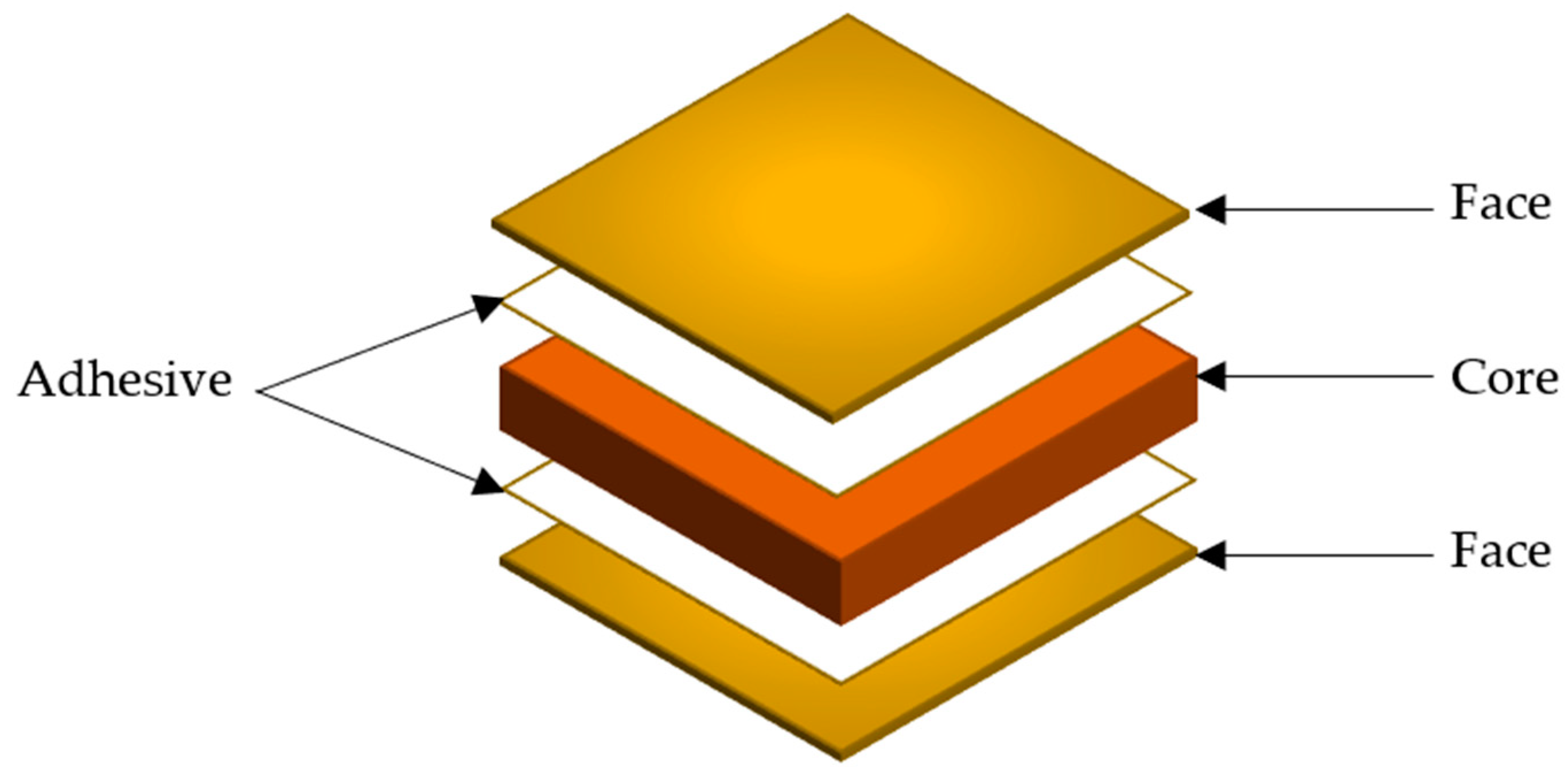
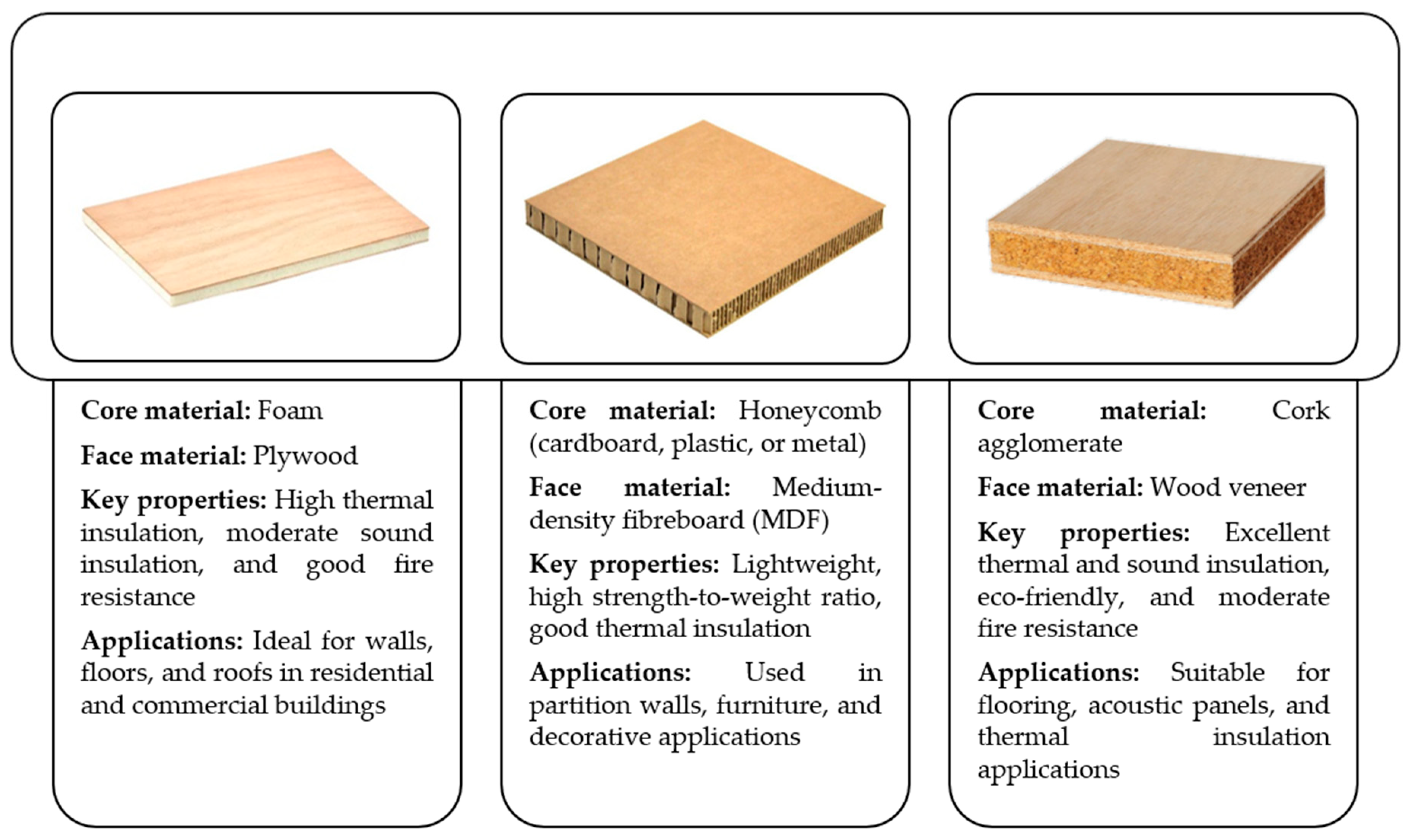




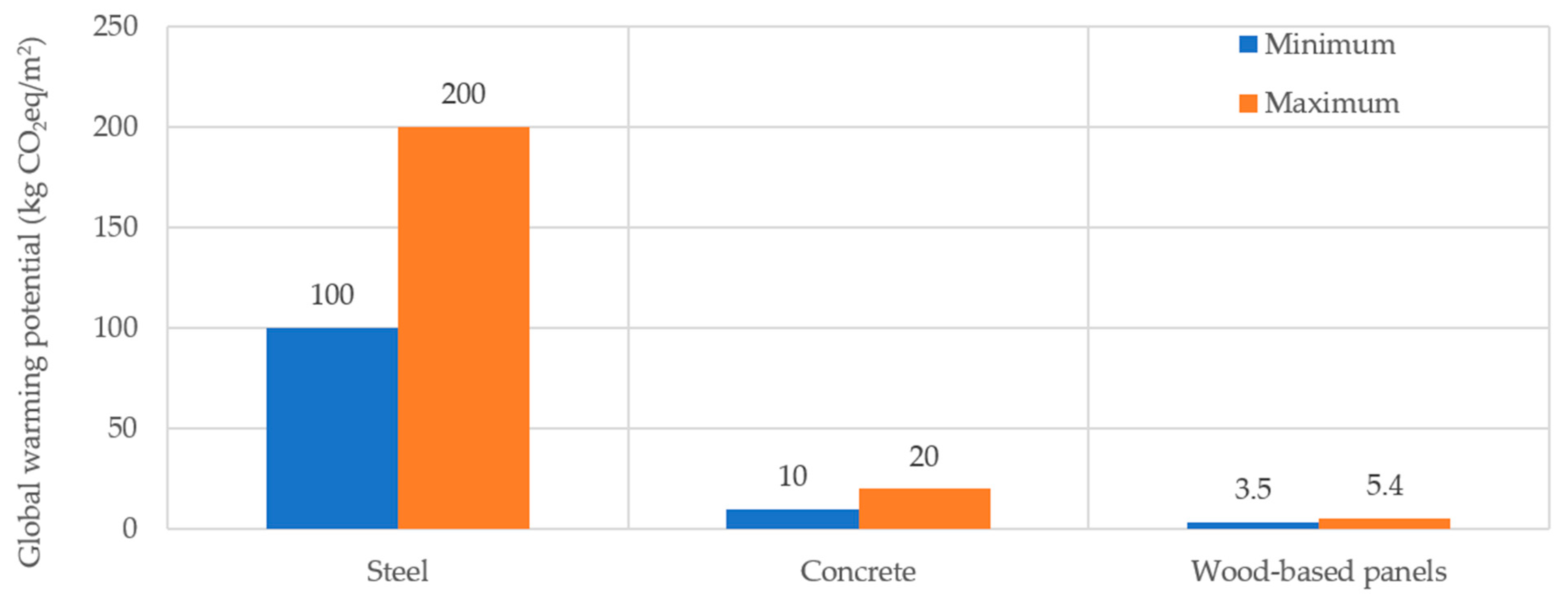
| Panel Type | Core Material | MOE (GPa) | MOR (MPa) | Density (kg/m³) | Thickness (mm) | Source |
|---|---|---|---|---|---|---|
| Wood-based panels with plywood faces | Stiffener/foam | 6.20 | 26.10 | 325 | 64 | [42] |
| Wood-based panels with plywood faces | Thermoplastic composite | 4.18 | 22.60 | 235 | 59 | [42] |
| Conventional plywood | None | 9.20 | 36.60 | 680 | 50 | [42] |
| Wood-based panels (particleboard, MDF, OSB, plywood) | Various internal layers | 8.88 | 92.90 | N/A | MDF: 12.30, Plywood: 3.64 | [83] |
| Wooden panels with auxetic core and oval cells | Auxetic core, oval cells | 3.30 | 26.60 | <400 | 20 | [79] |
| Wood-based composite panels | Kagome lattice core, particleboard facings | N/A | Flatwise: 2.64; edgewise: 6.4 | 392 | 38 | [20] |
| Bamboo–wood corrugated sandwich panels | Corrugated core | 5.21 | 38.53 | N/A | 18 | [80] |
| Wooden panels with corrugated cores | Corrugated core | 1.45 | 4.64 | 228 | 47.8 | [61] |
| Material Type | Specific Material | Density (kg/m3) | Thermal Conductivity—λ (W/mK) | References |
|---|---|---|---|---|
| Wood-based sandwich panels | Plywood-faced sandwich panel of the fiberboard core of a density of 340 kg/m3 | 340 | 0.070 | [13] |
| Plywood-faced sandwich panel of the fiberboard core of a density of 410 kg/m3 | 410 | 0.077 | [13] | |
| Eco-sustainable wood waste panel | 282 to 398 | 0.071 to 0.084 | [45] | |
| Natural rubber and rubber wood panel | 410 to 550 | 0.070 to 0.080 | [52] | |
| Alder veneer with aluminium core | N/a | 0.108 to 0.262 | [86] | |
| Scots pine veneer with polypropylene core | N/a | 0.111 to 0.259 | [86] | |
| Ferrocement with coconut fibre | N/a | 0.221 | [87] | |
| Wood-based materials | Soft wood | 348–661 | 0.680–1.12 | [90,91] |
| Hard wood | 615–750 | 1.060 to 1.250 | [90,91] | |
| Cross-laminated timber (CLT) | 480–500 | 0.120 to 0.130 | [92,93] | |
| Coconut wood CLT | 655 to 972 | 0.153 to 0.264 | [88] | |
| Oriented strand board (OSB) | 0.13 | [94] | ||
| Laminated strand lumber (LSL) | 0.081 to 0.126 | [95] | ||
| Plywood (lightweight) | 560 | 0.150 | [90] | |
| Plywood (heavyweight) | 700 | 0.150 | [90] | |
| Additional materials | Concrete | 1618 | 0.8 to 2.0 | [90,96] |
| Steel | 7850 | 50 | [52] | |
| Glass | 2500 to 2600 | 0.8 | [97] | |
| Aluminum | 2700 | 237 | [98] |
| STC | What Can Be Heard at This Level |
|---|---|
| 25 | Soft speech can be heard and understood. |
| 30 | Normal speech can be heard and understood. |
| 35 | Loud speech can be heard and understood. |
| 40 | Loud speech can be heard, but not understood. |
| 45 | The threshold at which privacy begins. |
| 50 | Loud sounds can be heard, but are very faint. |
| 60+ | At this level, good soundproofing begins. Neighbours generally are not disturbed by very loud speech from inside. |
| Code | Type of Material | Thickness (mm) | Density (kg/m³) | Porosity | MOR (MPa) | MOE (GPa) | Sound Absorption Coefficient (α) |
|---|---|---|---|---|---|---|---|
 | High-density fiberboard (HDF) + rattan mat HDF 8 mm, rattan mat 3 mm | 11.0 | 753 | 0.50 | 28.1 L * 25.6 P ** | 1.99 L 1.89 P | 0.01–0.4 |
 | High-density fiberboard (HDF) + bamboo mat HDF 8 mm, bamboo mat 2 mm | 10.0 | 848 | 0.43 | 37.0 L 29.2 P | 5.22 L 2.64 P | 0.01–0.16 |
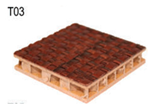 | Honeycomb + Lloyd loom mat Honeycomb paper core 5 mm, 2 × facing HDF 2 mm, 1 × facing loom mat 1.2 mm | 10.2 | 413 | 0.72 | 16.6 L 11.4 P | 2.20 L 1.93 P | 0.01–0.23 |
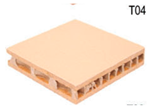 | Honeycomb + synthetic leather Honeycomb paper core 5 mm, 2 × facing HDF 2.5 m, 1 × facing synthetic leather 0.6 mm | 10.6 | 517 | 0.66 | 19.7 L 13.6 P | 2.42 L 1.98 P | 0.01–0.08 |
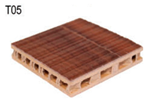 | Honeycomb + veneer Honeycomb paper core 5 mm, 1 × facing HDF 2.5 mm, 1 × facing oak veneer 2.3 mm | 9.8 | 456 | 0.70 | 15.8 L 18.1 P | 2.87 L 2.12 P | 0.01–0.18 |
 | Honeycomb + oak + texture Honeycomb paper core 5 mm, 2 × facing oak veneer 2.75 mm | 10.5 | 471 | 0.69 | 14.4 L 11.8 P | 2.99 L 1.39 P | 0.01–0.27 |
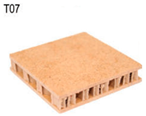 | Honeycomb Honeycomb paper core 5 mm, 2 × facing HDF 2.5 mm | 10.0 | 382 | 0.75 | 6.6 L 6.3 P | 2.56 L 2.43 P | 0.01–0.25 |
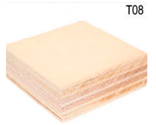 | Poplar plywood | 18.4 | 515 | 0.66 | 40.5 L 40.9 P | 4.88 L 4.73 P | 0.01–0.12 |
 | Exotic plywood | 7.9 | 354 | 0.76 | 32.9 L 0 P | 3.39 L 0 P | 0.04–0.125 |
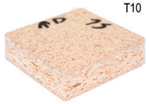 | Particleboard | 16.0 | 481 | 0.68 | 9.5 L 0 P | 2.08 L 0 P | 0.04–0.13 |
 | Medium-density fibreboard (MDF) | 18.0 | 558 | 0.63 | 31.4 L 0 P | 3.17 L 0 P | 0.02–0.13 |
 | Purenit (recycling material) | 3.1 | 553 | 0.63 | 6.3 L 0 P | 0.500 L 0 P | 0.01–0.27 |
 | Oriented strand board (OSB/3) | 17.5 | 613 | 0.59 | 30.5 L 18.8 P | 6.13 L 3.41 P | 0.01–0.14 |
 | DendroLight—core Pine wood core 22 mm | 22.3 | 270 | 0.82 | 1.8 L 1.2 P | 0.2 L 0.15 P | 0.01–0.64 |
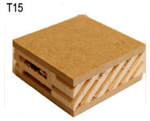 | DendroLight—HDF Pine wood core 14.5 mm, 2 × facing HDF 4 mm | 22.5 | 493 | 0.67 | 22.3 L 22.5 P | 2.92 L 2.85 P | 0.01–0.12 |
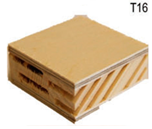 | DendroLight—birch plywood Pine wood core 14.5 mm, 2 × facing birch plywood 4 mm | 22.5 | 459 | 0.69 | 55.5 L 23.8 P | 9.17 L 4.39 P | 0.01–0.13 |
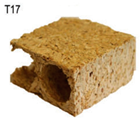 | Tube particleboard | 28 | 220 | 0.85 | 1.1 L 0.6 P | 0.52 L 0.11 P | 0.5–0.65 |
| Class | Description | Contribution to Fire |
|---|---|---|
| A1 | Non-combustible | No contribution to fire |
| A2 | Non-combustible with limited contribution | Very limited contribution to fire |
| B | Combustible with very limited contribution | Limited contribution to fire |
| C | Combustible | Moderate contribution to fire |
| D | Combustible | High contribution to fire |
| E | Combustible | Very high contribution to fire |
| F | Unclassified | No performance determined |
Disclaimer/Publisher’s Note: The statements, opinions and data contained in all publications are solely those of the individual author(s) and contributor(s) and not of MDPI and/or the editor(s). MDPI and/or the editor(s) disclaim responsibility for any injury to people or property resulting from any ideas, methods, instructions or products referred to in the content. |
© 2024 by the authors. Licensee MDPI, Basel, Switzerland. This article is an open access article distributed under the terms and conditions of the Creative Commons Attribution (CC BY) license (https://creativecommons.org/licenses/by/4.0/).
Share and Cite
Vladimirova, E.; Gong, M. Advancements and Applications of Wood-Based Sandwich Panels in Modern Construction. Buildings 2024, 14, 2359. https://doi.org/10.3390/buildings14082359
Vladimirova E, Gong M. Advancements and Applications of Wood-Based Sandwich Panels in Modern Construction. Buildings. 2024; 14(8):2359. https://doi.org/10.3390/buildings14082359
Chicago/Turabian StyleVladimirova, Elena, and Meng Gong. 2024. "Advancements and Applications of Wood-Based Sandwich Panels in Modern Construction" Buildings 14, no. 8: 2359. https://doi.org/10.3390/buildings14082359





